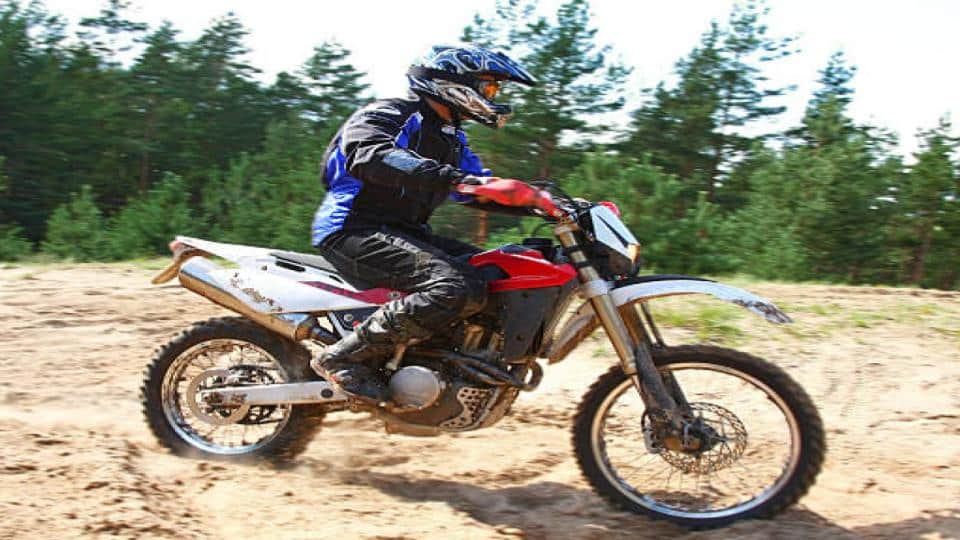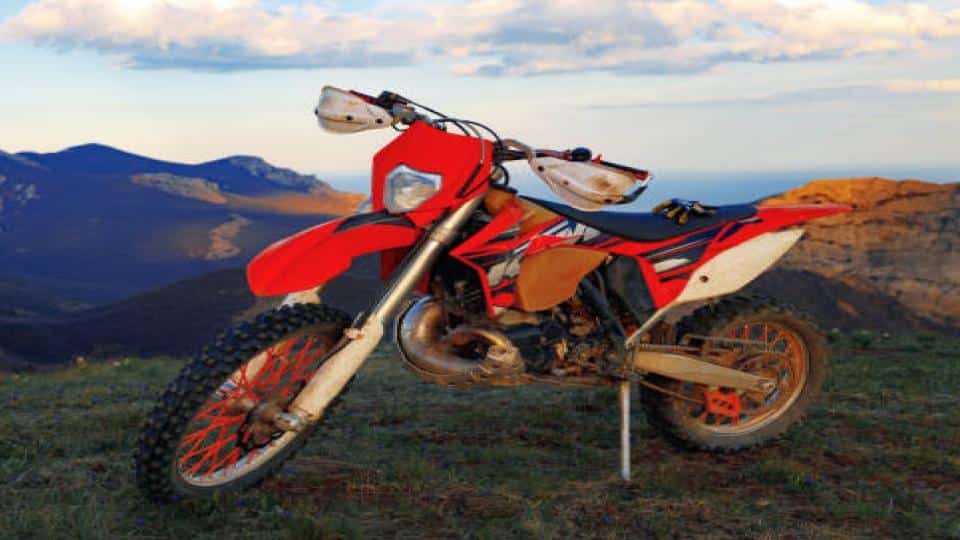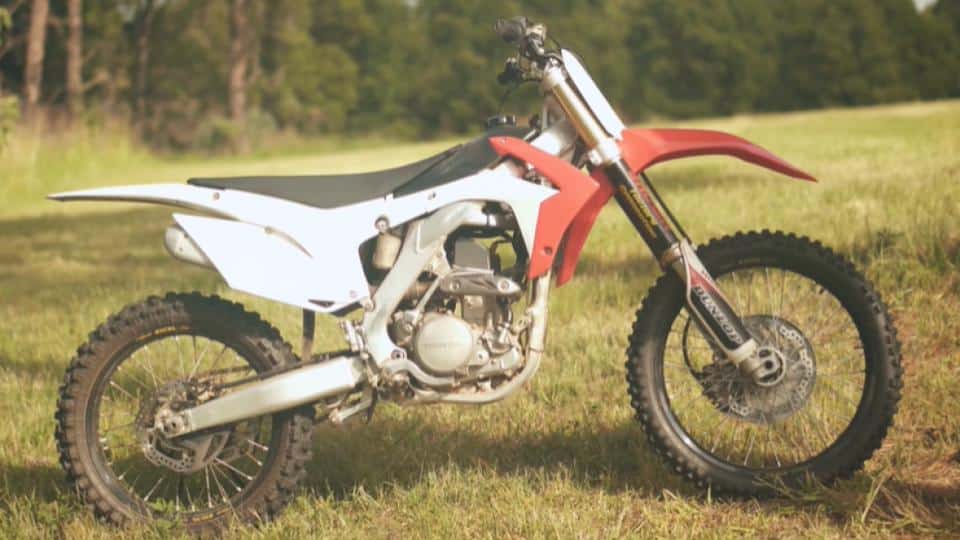All Dirt Bike Sizes (Length, Height, and Width): Which One to Pick

If you are eyeing a dirt bike like a 250 or 450, but have concerns about how well you will fit on it, don’t worry because we’ve got you covered.
You need to know about the different dirt bike sizes, so you make an informed choice. There are specific sizes for adults and kids. Getting the right size is important for overall safety and to guarantee the best experience every time you are on a technical or open-ground offroad terrain.
Keep on reading to learn more!
Table of Contents
Dirt Bike Dimensions
To pick a good size offroad motorcycle, you first need to understand the different dirt bike sizes dimensions.
How Long Is a Dirt Bike?

The first important dirt bike dimension is the length, which is measured from the rear to the front tip. The total length includes the taillights, mudguards, and front and rear wheels.
Your offroad motorcycle’s length can determine the strain and comfort your body will experience while riding. The average dirt bike length for kids is about 56 inches, and for adults, it is around 85.7 inches.
The length of a dirt bike determines how far the handlebars are from the seat. The farther the handlebars are, the more strain you will feel when trying to reach your primary steering.
For a comfortable ride, we recommend an optimum length that will allow you to easily reach the primary steering, especially on long offroad rides.
You could also get a slightly longer offroad motorcycle and adjust the wheelbase to get a comfortable space between the handlebars and the seat.
How High Should a Dirt Bike Be?

The height of a dirt bike is determined by the seat height, which is measured from the bottom of the rear wheel to the top of the seat/underneath the rear fender. Seat height determines how easy and painless the bike will be to get on and ride.
This dimension usually influences handling by affecting the combined center of gravity of rider and bike. It is also an ergonomic consideration.
Dirt bike seat height ranges from 34 to 37.5 inches, depending on your model. The most ideal seat height should allow the ball of your foot and toes to touch the ground. The heel of your foot, however, should be in the air. This may feel uncomfortably tall if you are a new rider. But, this is the real deal.
If you choose a dirt bike that allows you to stand flat-footed, chances are that you will be riding in a cramped position and your chances of foot injury will increase.
What If I Am Too Tall?

The big problem with offroad motorcycles is the cockpit, which is designed to fit the average person. Too short and you cannot touch the ground, too tall and you have to squeeze yourself onto the bike.
When standing in the correct default body position, a taller rider has to crouch more compared to an average rider. This is a lot more tiring. It also put the body weight to the rear more, which can affect the center of gravity.
When sitting, a taller rider is forced to sit more to the rear. Sliding forward to the ideal position proves to be cramping, making the feet vulnerable.
The cramping position makes the transition between sitting and standing very tiring. This is a tough situation, especially on technical terrains.
Setup Tips
Here are useful setup tips that can help you make the cockpit bigger:
- Mount the bars forward
- Move your footpegs lower and farther back
- Get a taller seat that will increase the overall seat height of the bike
- Get a longer gearshift lever
What If I Am Too Short?
It is truly tough being short and in love with trail riding. Any decent dirt bike has a lot of suspension travel, which simply means a high seat height. This is a big problem any time you want to stop and touch the ground. Women are, in general, smaller on average when compared to men. It is always tough to find the best motorcycle for short women. Try the bike setup tips listed below on your bike.
Setup Tips
- Make large holes in the seat foam to increase its softness
- Replace the seat with gel inserts and a softer foam
- Increase the rear suspension sag and slide the forks up through the triple clamps to match
- Lowering link for the rear suspension and adjusting the front forks to match
- Get the adjustments done at a suspension shop
How Wide Is a Dirt Bike?
The average width of a kid’s dirt bike is around 25.7 inches, while that for adults is roughly 32.4 inches.
The width can influence the aerodynamics and bulkiness of your offroad motorcycle. The width, however, is a matter of personal preference. You may be interested in a wider, bulkier dirt bike, while your friend may opt for a slimmer-looking machine.
What Is the Effect of the Wheelbase?
The wheelbase is usually measured from the point the front wheel of a dirt bike touches the trail to the point where the rear wheel is in contact with the trail.
The wheelbase plays a major role in the characteristic of a dirt bike. It affects how tightly an offroad motorcycle turns around corners, how the bike is going to pitch, and it also influences the overall stability as well as agility.
Wheelbase determines the directional stability of your offroad motorcycle. This is the tendency of your bike to want to stay aligned in the direction of travel. So, a longer wheelbase makes the bike more directionally stable.
The wheelbase tends to influence the pitching of the bike. This is so because when accelerating or braking, the load is transferred from one wheel to the other. So, when you accelerate, the load is transferred to the rear wheel, and when you brake, the load is transferred to the front wheel.
The amount of load transferred is proportional to the center of gravity height as well as inversely proportional to your wheelbase. So, the longer your wheelbase is, the less load is transferred during acceleration and braking. The shorter the wheelbase, the more load is transferred.
Dirt Bike Displacement
Another important factor to consider when looking at different dirt bike sizesis displacement, which is represented in cc.
Motors have pistons. You’ve probably heard someone saying eight-cylinder—this is a motor that has eight pistons. Four-cylinder has four pistons. A piston is a cylindrical-shaped part that moves up and down inside a tube referred to as the cylinder. It uses a finely-tuned combination of fuel and air to generate power.
An engine displacement, therefore, is the volume that is swept by a piston inside a cylinder from top to bottom. The initials cc means cubic centimeters, which is the measurement of the volume of the cylinders.
The two factors that determine displacement are the distance from the top to the bottom (stroke) as well as the diameter of the cylinder that a piston is traveling in (bore).
More displacement improves durability and all aspects of performance. The bike doesn’t have to work as hard to produce more torque and horsepower while using less fuel.
What About the Weight of the Bike?
Another important thing to consider when looking for the perfect dirt bike size is weight, which is usually measured in pounds.
The average weight of an adult dirt bike ranges from 200 to 250 pounds, which normally varies from one year to the next based on upgrades. For kids’ dirt bikes, the average weight ranges from 130 to 150 pounds, which could vary with newer models.
Wet & Dry Weight
Wet or curb weight includes the weight of fuel tank and 2T oil, brake fluid radiator coolant, fork/rear shock oil, engine oil, tires, brake fluid, and battery. Dry weight, on the other hand, includes the weight of the bike minus fluids and oils.
Lighter bikes can easily hit high speeds because they carry less weight compared to heavier ones. Heavy bikes, however, offer more stability and control on high-speed terrain.
Dirt Bike Size Chart for Kids
Here are our recommended sizes for kids in a chart:
Age (Years) | Recommended Engine Displacement (cc) | Recommended Seat Height (Inches) |
5 – 8 | 50 | 23 – 25 |
8 – 9 | 110 | 24 – 26 |
9 – 10 | 110 | 24 – 28 |
10 – 12 | 110/125 | 26 – 31 |
12 – 14 | 125 | 31 - 35 |
If you're looking for a bike for your kid, you might want to know how much kid dirt bikes cost.
Dirt Bike Size Chart for Adults
Here are our recommended sizes for adults in a chart:
Height (Ft & In) | Recommended Engine Displacement (cc) | Recommended Seat Height (Inches) |
6’ | 450 | 37.5 |
5’10” | 250 | 35 – 39 |
5’8” | 125/150 | 34 – 38 |
5’6” | 140/150 | 34 – 37 |
5’4” | 140 | 33 – 36 |
5’2” | 125 | 31 – 35 |
What Other Factors Should I Consider?
Picking the ideal dirt bike size is an art that you will perfect one year after another. In addition to what we have discussed above, here are additional things that will help with your selection:
New or Second-Hand
A good rider on a used dirt bike can outperform an average rider on the latest model. A new model usually has zero problems and the warranty is reliable, unlike a used model that may come with a problem or two and with no warranty.
Two-Stroke Or Four-Stroke
As a rule of thumb, 4-strokes will suit less experienced riders better. Expert trail riders, on the other hand, are better at handling a 2-stroke power delivery and they prefer them for enduro riding. A 4-stroke is usually the go-to design for more open trails, while a 2-stroke is ideal for narrow technical terrains.
Shorter Or Taller Rider
Shorter and taller riders often ask which dirt bike will suit them better. There are plenty of mods regardless of the bike you choose.
Shorter riders need rear subframe mods, suspension mods, and lower seat height. Tall riders, on the other hand, need lowered footpegs, rear subframe mods, raised seat, risers and/or high bend bars, and bars forward.
Size Engine Vs Experience
Guys usually debate which size engine they should get. Many beginner riders want the most powerful engine possible for boosted performance. That’s okay if you believe a bigger engine will make you stand out on the trail.
But, if you are serious about developing your skills and not hurting yourself, then you will be better off with a smaller engine while learning.
FAQs
What age is suitable for a 125cc dirt bike?
A 125cc bike is a suitable choice for kids ranging from 12 to 14 years. This bike is powerful enough to get a teen into trail riding without hurting him or herself.
How tall is a 125cc dirt bike?
The typical seat height ranges for a 125cc dirt bike are 31 to 35 and 33 to 36 inches.
What is the most ideal dirt bike size for women?
Average-sized women are better off with a dirt bike that has a little taller seat height ranging from 31 to 34 inches.
How tall must a rider be to ride a 250cc dirt bike?
There isn’t a set height requirement for a 250cc bike. But, you can know it is your best fit by sitting on it and making sure that the ball of your foot and toe touch the ground.
Is a 450cc dirt bike too big for a beginner rider?
A 450cc model is too big for a beginner. You will learn better with a 125cc as you master the art of trail riding.
How fast can a 50cc dirt bike go?
How fast does a 50cc dirt bike go? Most 50cc models out there are engineered to hit speeds ranging from 25 to 40 mph. The speed range of 50cc bikes is perfect for kids aged 5 to 7.
The Bottom Line
As you have seen, there are many factors to consider when looking for the most ideal dirt bike size. Factors like the length, width, seat height, wheelbase, engine displacement, and weight.
A junior rider can get into trail riding with a 50cc that is easy to control when accelerating and decelerating before adding the complexity of a clutch. For slightly older kids who want to start learning dirt biking, a 110cc is a good starting point. Adults, on the other hand, can start with a 125cc going up.
Always make sure that the ball of your foot and toes are touching the ground when testing the seat height of the bike. This will help you avoid cramping and hurting yourself.
